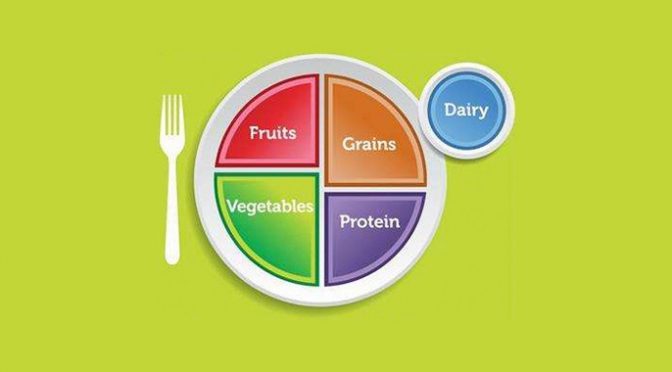1). Load the plate with vegetables and fruits
Use the healthy plate diagram as the best guide to balanced diet. Make sure half of the plate contains vegetables and fruits. On the other side of the plate, cereals (especially whole grain food like whole wheat, oats, brown rice) should constitute a quarter and healthy protein/meat should be the other quarter. It is good to include healthy fats and complex carbohydrates as part of diet.
Milk/yogurt can also be taken along with a meal. The amount of milk should be restricted as a child grows older, allowing the child to get important nutrients (which are lacking in milk) from other food.
2). Advice on consumption of sugar and sugar substitutes
You must offer those foods to children which do not have added sugar or sugar substitutes. It is better if you limit refined sugar consumption in any of the following forms like white sugar, honey, brown sugar or syrups, etc. they all contain calories that can contribute to tooth decay in your children.
Sugar substitutes are quite sweeter than the normal sugar and basically have no nutritional value in it. This may lead to craving for sweet food thereby making it difficult for your child to adjust to any kinds of healthy regular fruits and vegetables. So if you can limit them in your child’s diet that could be great.
3). Healthy beverages
You must offer your child water when they are thirsty for instance between the meals and snacks. You must consider limiting juice to one serving of 100% unsweetened fruit juice per day. Instead of fruit juices, serving actual fruits that have fibre is beneficial to your child’s diet. It is also found that children tend to drink too much water at mealtime or between the meals thereby making them feel full and reluctant to eat more.
4). Advice on salt consumption
Salt is basically sodium that is a mineral responsible for proper fluid balance in our body. Nevertheless, consuming sodium or salt in high quantities can lead to high blood pressure thereby increasing the risk of heart disease. You must offer your child food with the least salt or sodium portion in it. Sodium content in processed and pre-packaged foods are generally high.
5). Healthy or good Fats
Healthy fats or good fats are those which contain essential fatty acids like omega-3 and omega-6. These healthy fats can’t be produced from our own body so has to be taken in through other foods. You can cook your child’s meals in vegetable oils like olive or soybean. Healthy fat consumption can be promoted through the salad dressings with healthy oils, peanut butter or mayonnaise. Unhealthy fats contain more saturated or trans fats that can ultimately raise the risk of heart disease. Limiting the intake of such hidden fats, processed meals, preservatives can be beneficial for your child’s health.
The primary job for you as a parent should be setting regular meal and snack time that probably works for the whole family together. You must offer a balanced meal that contains a variety of foods from all groups. Serving food in mashed form or small pieces can prevent choking in case your child is too young.
If you have questions on your child’s diet, you must visit a child specialist or pediatrician like Dr. Rahul Reddy for better understanding the dietary needs of your child.



0 Comment